Friction and Wear Behavior of Double-Walled Carbon Nanotube-Yttria-Stabilized ZrO2 Nanocomposites Prepared by Spark Plasma Sintering †
Abstract
:1. Introduction
2. Materials and Methods
2.1. Powder Preparation
2.2. Spark Plasma Sintering
2.3. Characterization
3. Results and Discussion
4. Conclusions
Author Contributions
Funding
Institutional Review Board Statement
Informed Consent Statement
Data Availability Statement
Acknowledgments
Conflicts of Interest
References
- Zhang, W.; Ma, G.J.; Wu, C.W. Anti-friction, wear-proof and self-lubrication application of carbon nanotubes. Rev. Adv. Mater. Sci. 2014, 36, 75. [Google Scholar]
- Morales-Florez, V.; Domínguez-Rodríguez, A. Mechanical properties of ceramics reinforced with allotropic forms of carbon. Prog. Mater. Sci. 2022, 128, 100966. [Google Scholar] [CrossRef]
- Sarkar, S.; Das, P. Processing and properties of carbon nanotube/alumina nanocomposites: A review. Rev. Adv. Mater. Sci. 2014, 37, 53. [Google Scholar]
- An, J.-W.; You, D.-H.; Lim, D.-S. Tribological properties of hot-pressed alumina–CNT composites. Wear 2003, 255, 677. [Google Scholar] [CrossRef]
- Lim, D.-S.; You, D.-H.; Choi, H.-J.; Lim, S.-H.; Jang, H. Effect of CNT distribution on tribological behavior of alumina–CNT composites. Wear 2005, 259, 539. [Google Scholar] [CrossRef]
- Xia, Z.H.; Lou, J.; Curtin, W.A. A multiscale experiment on the tribological behavior of aligned carbon nanotube/ceramic composites. Scr. Mater. 2008, 58, 223. [Google Scholar] [CrossRef]
- Yamamoto, G.; Omori, M.; Yokomizo, K.; Hashida, T.; Adachi, K. Structural characterization and frictional properties of carbon nanotube/alumina composites prepared by precursor method. Mater. Sci. Eng. B 2008, 148, 265. [Google Scholar] [CrossRef]
- Keshri, A.K.; Huang, J.; Singh, V.; Choi, W.B.; Seal, S.; Agarwal, A. Synthesis of aluminum oxide coating with carbon nanotube reinforcement produced by chemical vapor deposition for improved fracture and wear resistance. Carbon 2010, 48, 431. [Google Scholar] [CrossRef]
- Ahmad, I.; Kennedy, A.; Zhu, Y.Q. Wear resistant properties of multi-walled carbon nanotubes reinforced Al2O3 nanocomposites. Wear 2010, 269, 71. [Google Scholar] [CrossRef]
- Hvizdoš, P.; Puchý, V.; Duszová, A.; Dusza, J.; Balazsi, C. Tribological and electrical properties of ceramic matrix composites with carbon nanotubes. Ceram. Int. 2012, 38, 5669. [Google Scholar] [CrossRef]
- Puchy, V.; Hvizdos, P.; Dusza, J.; Kovac, F.; Inam, F.; Reece, M.J. Wear resistance of Al2O3–CNT ceramic nanocomposites at room and high temperatures. Ceram. Int. 2013, 39, 5821. [Google Scholar] [CrossRef]
- Lee, K.-S.; Jang, B.-K.; Sakka, Y. Damage and wear resistance of Al2O3–CNT nanocomposites fabricated by spark plasma sintering. Ceram. Soc. Jpn. 2013, 121, 867. [Google Scholar] [CrossRef]
- Hentour, K.; Marsal, A.; Turq, V.; Weibel, A.; Ansart, F.; Sobrino, J.-M.; Chen, Y.M.; Garcia, J.; Cardey, P.-F.; Laurent, C. Carbon nanotube/alumina and graphite/alumina composite coatings on stainless steel for tribological applications. Mater. Today Commun. 2016, 8, 118. [Google Scholar] [CrossRef]
- Halder, R.; Sarkar, S.; Bandyopadhyay, S.; Chakraborti, P.C. Sintering and tribomechanical properties of gel-combustion-derived nano-alumina and its composites with carbon nanotubes. J. Mater. Sci. 2018, 53, 8989. [Google Scholar] [CrossRef]
- Ujah, C.O.; Von Kallon, D.V.; Aigbodion, V.S. Tribological Properties of CNTs-Reinforced Nano Composite Materials. Lubricants 2023, 11, 95. [Google Scholar] [CrossRef]
- Shin, J.H.; Hong, S.H. Microstructure and mechanical properties of single wall carbon nanotube reinforced yttria stabilized zircona ceramics. Mater. Sci. Eng. A-Struct. Mater. Prop. Microstruct. Process. 2012, 556, 382. [Google Scholar] [CrossRef]
- Kasperski, A.; Weibel, A.; Alkattan, D.; Estournès, C.; Turq, V.; Laurent, C.; Peigney, A. Microhardness and friction coefficient of multi-walled carbon nanotube-yttria-stabilized ZrO2 composites prepared by spark plasma sintering. Scr. Mater. 2013, 69, 338. [Google Scholar] [CrossRef]
- Melk, L.; Rovira, J.J.R.; Antti, M.-L.; Anglada, M. Coefficient of friction and wear resistance of zirconia–MWCNTs composites. Ceram. Int. 2015, 41 Pt A, 459. [Google Scholar] [CrossRef]
- Zhang, X.; Sun, C.; Ji, H.; Yang, M.; Zhang, H.; Tian, W.; Wu, Y.; Tolochko, O.V.; Wang, Y. A review of CNTs and graphene reinforced YSZ nanocomposites: Preparation, mechanical and anti-irradiation properties. Mater. Sci. Technol. 2023, 167, 27. [Google Scholar] [CrossRef]
- Pfeiffer, R.; Pichler, T.; Kim, Y.A.; Kuzmany, H. Double-wall carbon nanotubes. Top. Appl. Phys. 2008, 111, 495. [Google Scholar] [CrossRef]
- Kim, Y.A.; Yang, K.S.; Muramatsu, H.; Hayashi, T.; Endo, M.; Terrones, M.; Dresselhaus, M.S. Double-walled carbon nanotubes: Synthesis, structural characterization, and application. Carbon Lett. 2014, 15, 77. [Google Scholar] [CrossRef]
- Guiderdoni, C.; Pavlenko, E.; Turq, V.; Weibel, A.; Puech, P.; Estournès, C.; Peigney, A.; Bacsa, W.; Laurent, C. The preparation of carbon nanotube (CNT)/copper composites and the effect of the number of CNT walls on their hardness, friction and wear properties. Carbon 2013, 58, 185. [Google Scholar] [CrossRef]
- Kasperski, A.; Weibel, A.; Alkattan, D.; Estournès, C.; Laurent, C.; Peigney, A. Double-walled carbon nanotube/zirconia composites: Preparation by spark plasma sintering, electrical conductivity and mechanical properties. Ceram. Int. 2015, 41, 13731. [Google Scholar] [CrossRef]
- Flahaut, E.; Bacsa, R.; Peigney, A.; Laurent, C. Gram-scale CCVD synthesis of double-walled carbon nanotubes. Chem. Commun. 2003, 12, 1442. [Google Scholar] [CrossRef]
- Flahaut, E.; Peigney, A.; Laurent, C.; Rousset, A. Synthesis of single-walled carbon nanotube–Co–MgO composite powders and extraction of the nanotubes. J. Mater. Chem. 2000, 10, 249. [Google Scholar] [CrossRef]
- de Andrade, M.J.; Lima, M.D.; Skakalova, V.; Bergmann, C.P.; Roth, S. Electrical properties of transparent carbon nanotube networks prepared through different techniques. Phys. Status Solidi R 2007, 1, 178. [Google Scholar] [CrossRef]
- Mendelsohn, M.I. Average Grain Size in Polycrystalline Ceramics. J. Am. Ceram. Soc. 1969, 52, 443. [Google Scholar] [CrossRef]
- Flaureau, A.; Weibel, A.; Chevallier, G.; Estournès, C. Study of the densification and grain growth mechanisms occurring during spark plasma sintering of different submicronic yttria-stabilized zirconia powders. J. Eur. Ceram. Soc. 2021, 41, 3581. [Google Scholar] [CrossRef]
- Peigney, A.; Rul, S.; Lefevre-Schlick, F.; Laurent, C. Densification during hot-pressing of carbon nanotube–metal–magnesium aluminate spinel nanocomposites. J. Eur. Ceram. Soc. 2007, 27, 2183. [Google Scholar] [CrossRef]
- Ukai, T.; Sekino, T.; Hirvonen, A.; Tanaka, N.; Kusunose, T.; Nakayama, T.; Niihara, K. Science of Engineering Ceramics III; Trans Tech Publications Ltd.: Stafa-Zurich, Switzerland, 2006; Volume 317–318, p. 661. [Google Scholar]
- Fonseca, F.C.; Muccillo, R.; de Florio, D.Z.; Ladeira, L.O.; Ferlauto, A.S. Mixed ionic-electronic conductivity in yttria-stabilized zirconia/carbon nanotube composites. Appl. Phys. Lett. 2007, 91, 243107. [Google Scholar] [CrossRef]
- Kasperski, A.; Weibel, A.; Estournès, C.; Laurent, C.; Peigney, A. Multi-walled carbon nanotube–Al2O3 composites: Covalent or non-covalent functionalization for mechanical reinforcement. Scr. Mater. 2014, 75, 46. [Google Scholar] [CrossRef]
- Poyato, R.; Gallardo-Lopez, A.; Gutierrez-Mora, F.; Morales-Rodriguez, A.; Munoz, A.; Dominguez-Rodriguez, A. Effect of high SWNT content on the room temperature mechanical properties of fully dense 3YTZP/SWNT composites. J. Eur. Ceram. Soc. 2014, 34, 1571. [Google Scholar] [CrossRef]
- Garmendia, N.; Grandjean, S.; Chevalier, J.; Diaz, L.A.; Torrecillas, R.; Obieta, I. Zirconia–multiwall carbon nanotubes dense nano-composites with an unusual balance between crack and ageing resistance. J. Eur. Ceram. Soc. 2011, 31, 1009. [Google Scholar] [CrossRef]
- Mazaheri, M.; Mari, D.; Schaller, R.; Bonnefont, G.; Fantozzi, G. Processing of yttria stabilized zirconia reinforced with multi-walled carbon nanotubes with attractive mechanical properties. J. Eur. Ceram. Soc. 2011, 31, 2691. [Google Scholar] [CrossRef]
- Shim, D.H.; Jung, S.S.; Kim, H.S.; Cho, H.; Kim, J.K.; Kim, T.G.; Yoon, S.J. Effect of Carbon Nanotubes on the Properties of Spark Plasma Sintered ZrO2/CNT Composites. Arch. Metall. Mater. 2015, 60, 1315. [Google Scholar] [CrossRef]
- Hvizdoš, P.; Puchý, V.; Duszová, A.; Dusza, J. Tribological behavior of carbon nanofiber–zirconia composite. Scr. Mater. 2010, 63, 254. [Google Scholar] [CrossRef]
- Caillier, C.; Ayari, A.; Gouttenoire, V.; Benoit, J.-M.; Jourdain, V.; Picher, M.; Paillet, M.; Le Floch, S.; Purcell, S.T.; Sauvajol, J.-L.; et al. An Individual Carbon Nanotube Transistor Tuned by High Pressure. Adv. Funct. Mater. 2010, 20, 3330. [Google Scholar] [CrossRef]
- Aguiar, A.L.; Barros, E.B.; Capaz, R.B.; Souza, A.G.; Freire, P.T.C.; Filho, J.M.; Machon, D.; Caillier, C.; Kim, Y.A.; Muramatsu, H.; et al. Pressure-Induced Collapse in Double-Walled Carbon Nanotubes: Chemical and Mechanical Screening Effects. J. Phys. Chem. C 2011, 115, 5378. [Google Scholar] [CrossRef]
- Li, Y.; Wang, K.; Wei, J.; Gu, Z.; Wang, Z.; Luo, J.; Wu, D. Tensile properties of long aligned double-walled carbon nanotube strands. Carbon 2005, 43, 31. [Google Scholar] [CrossRef]
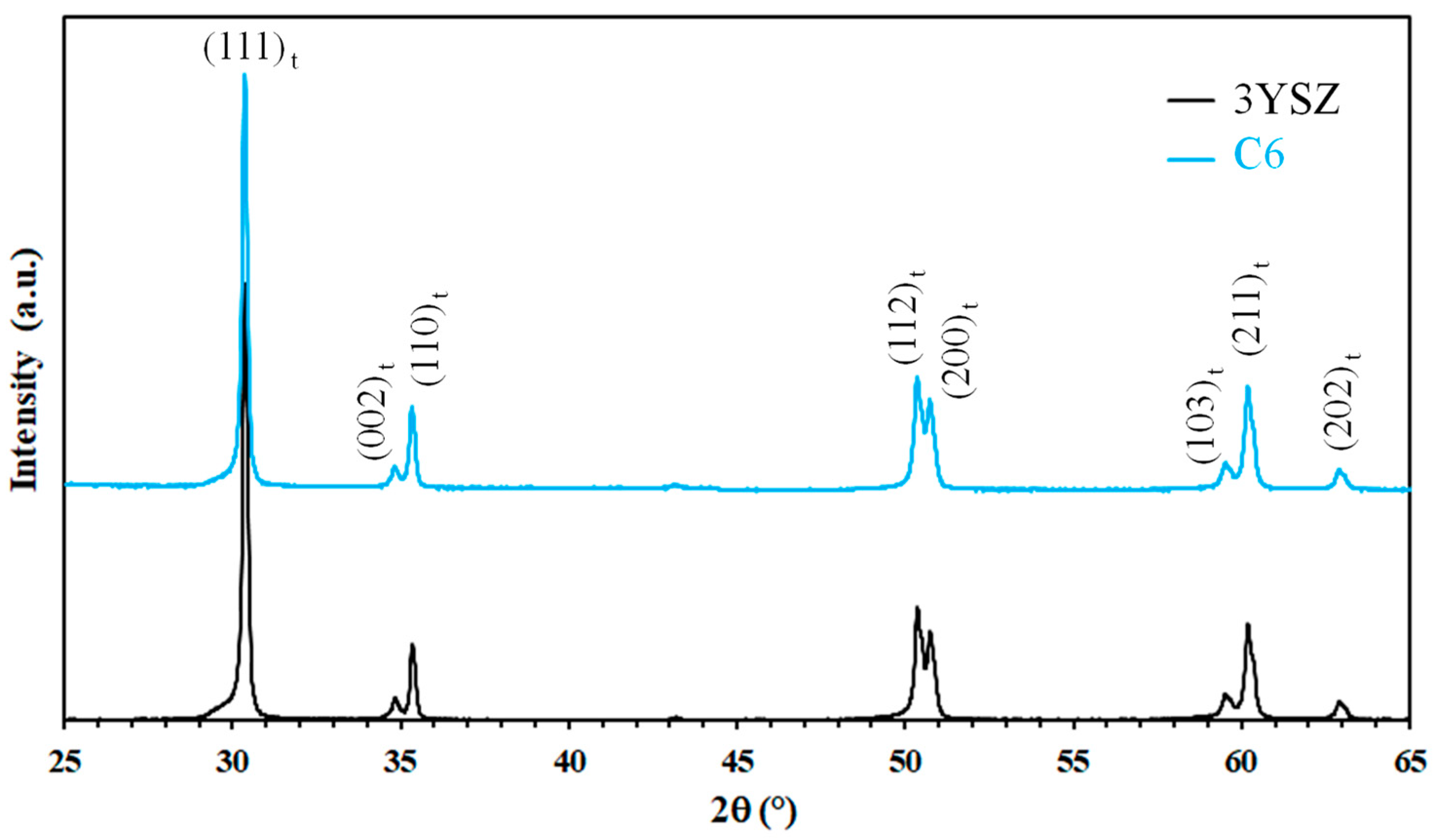
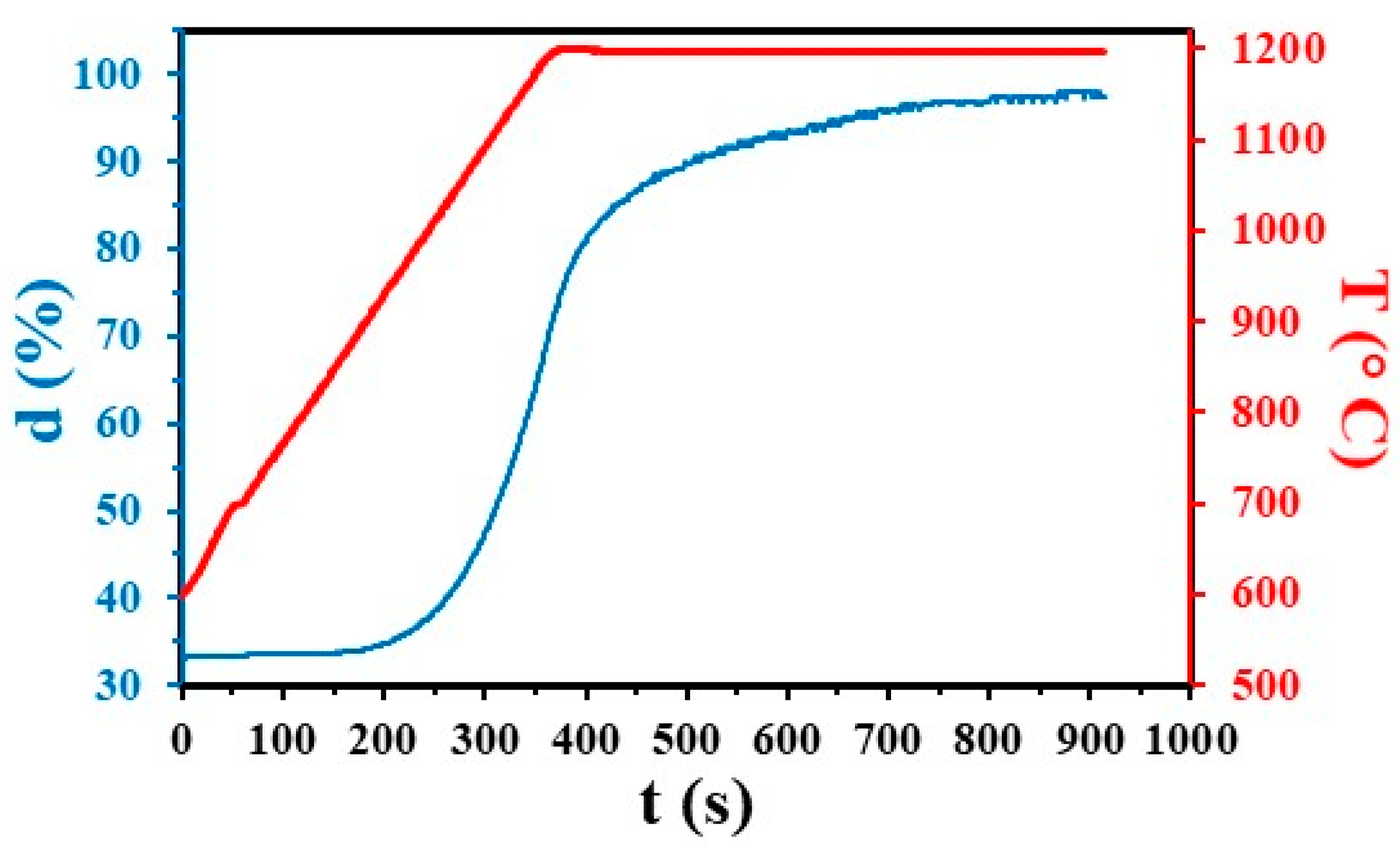
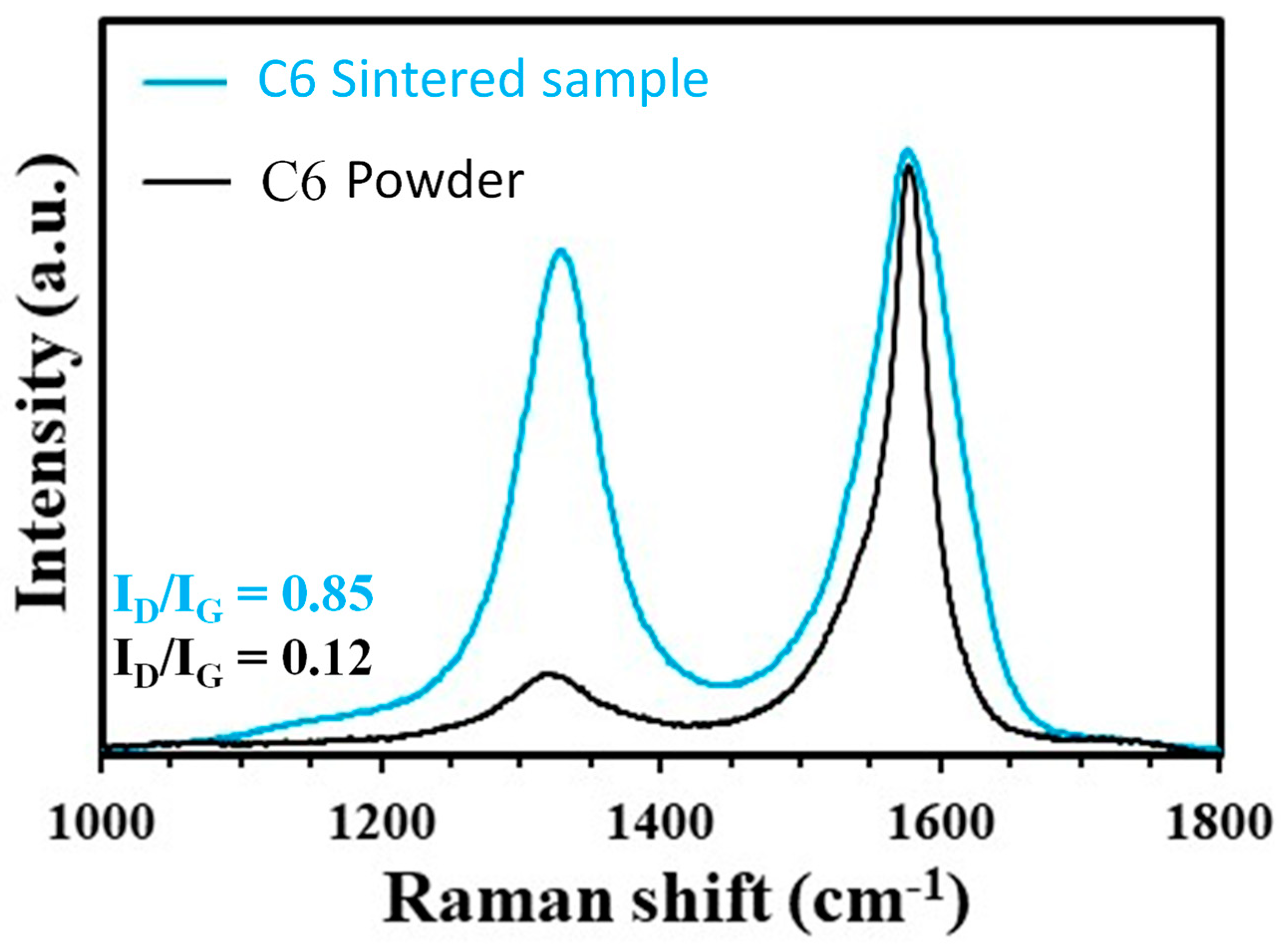

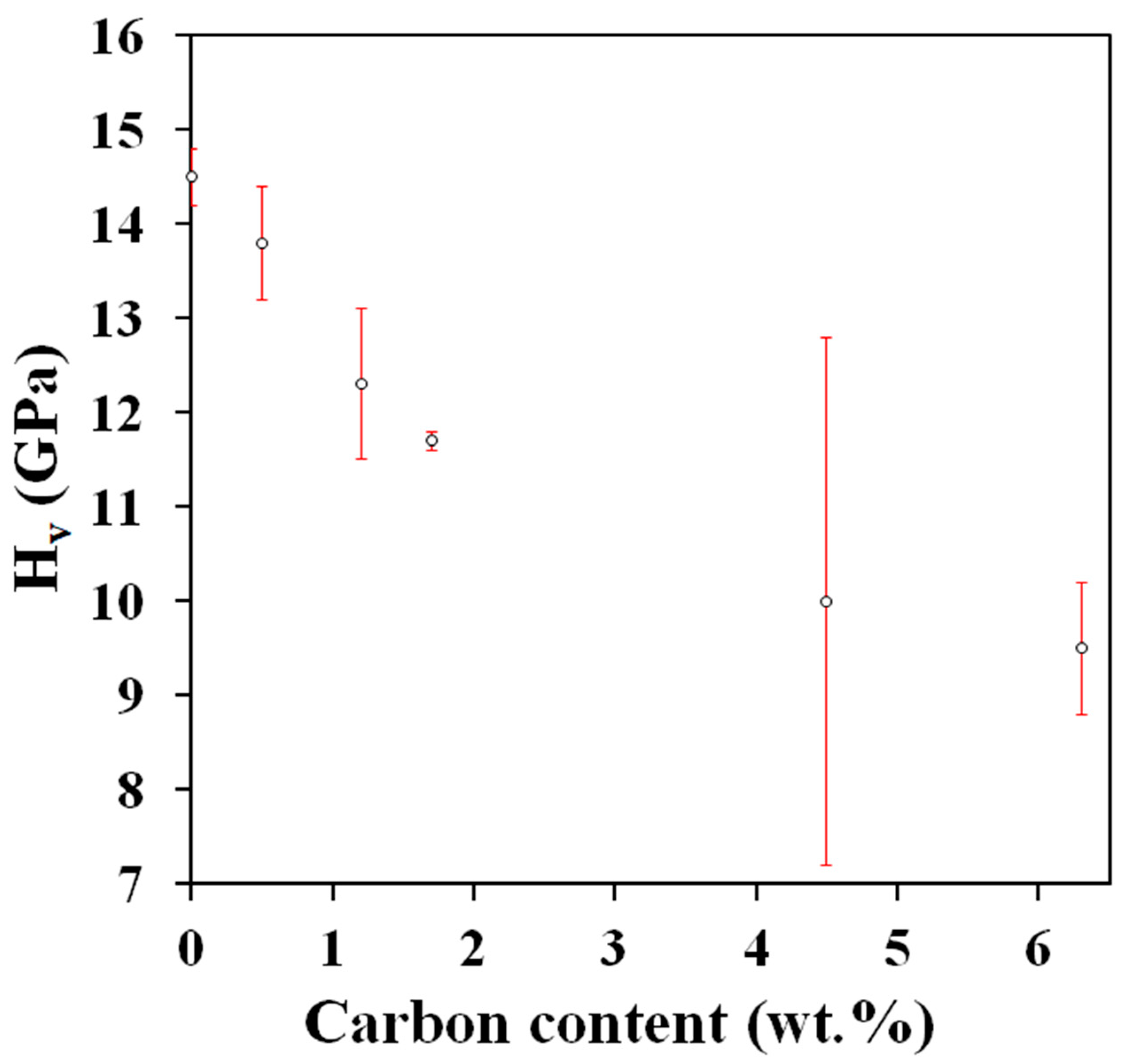

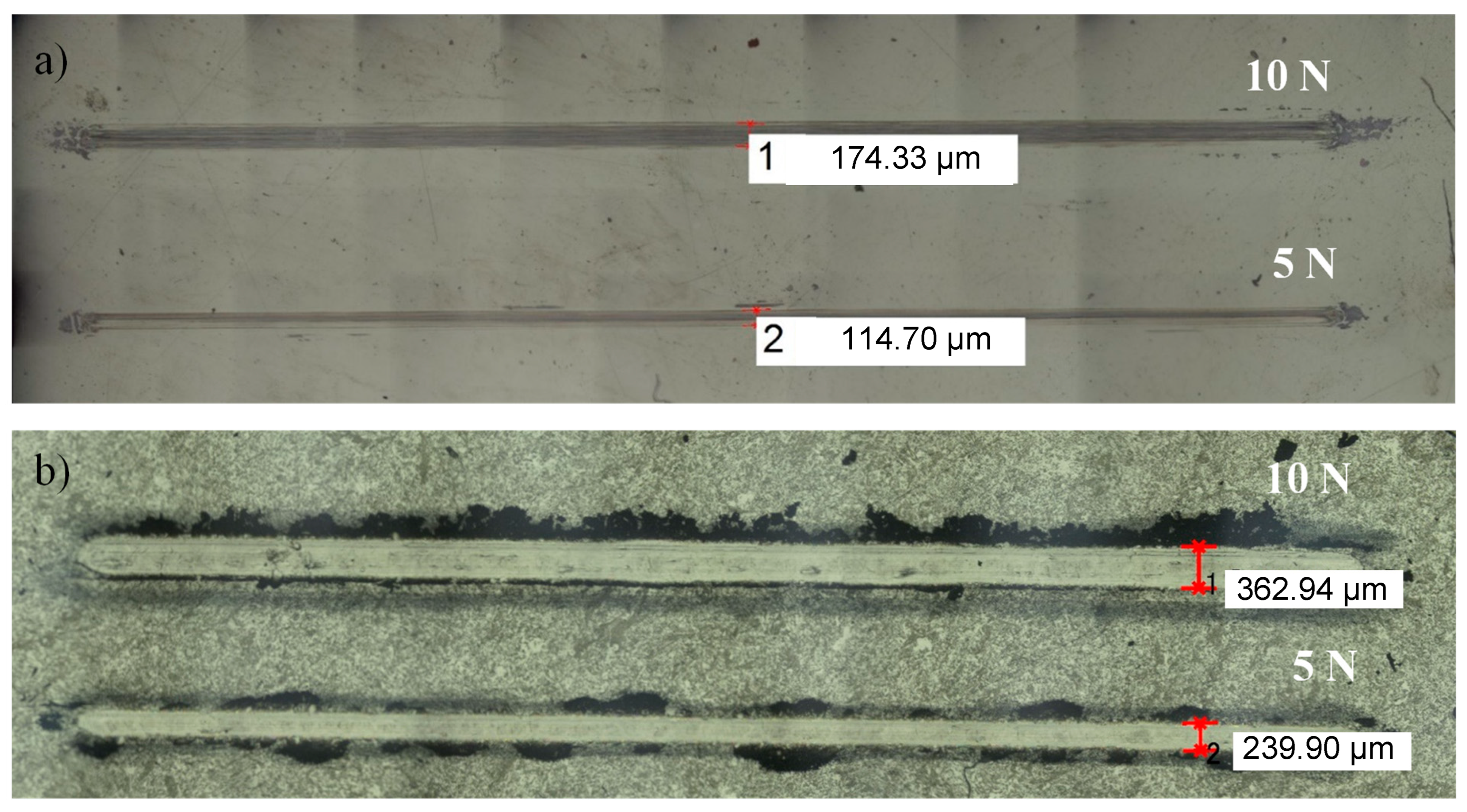
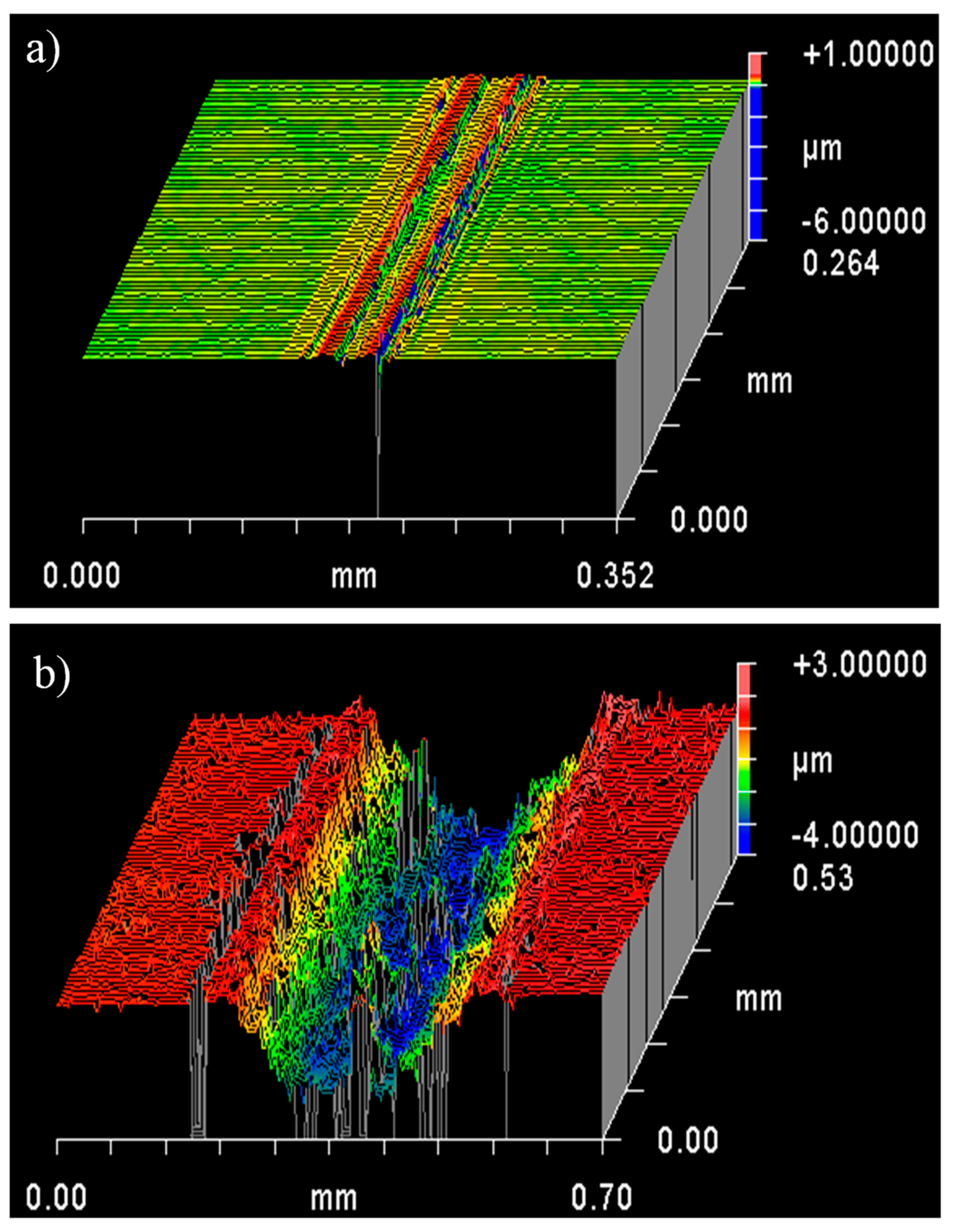
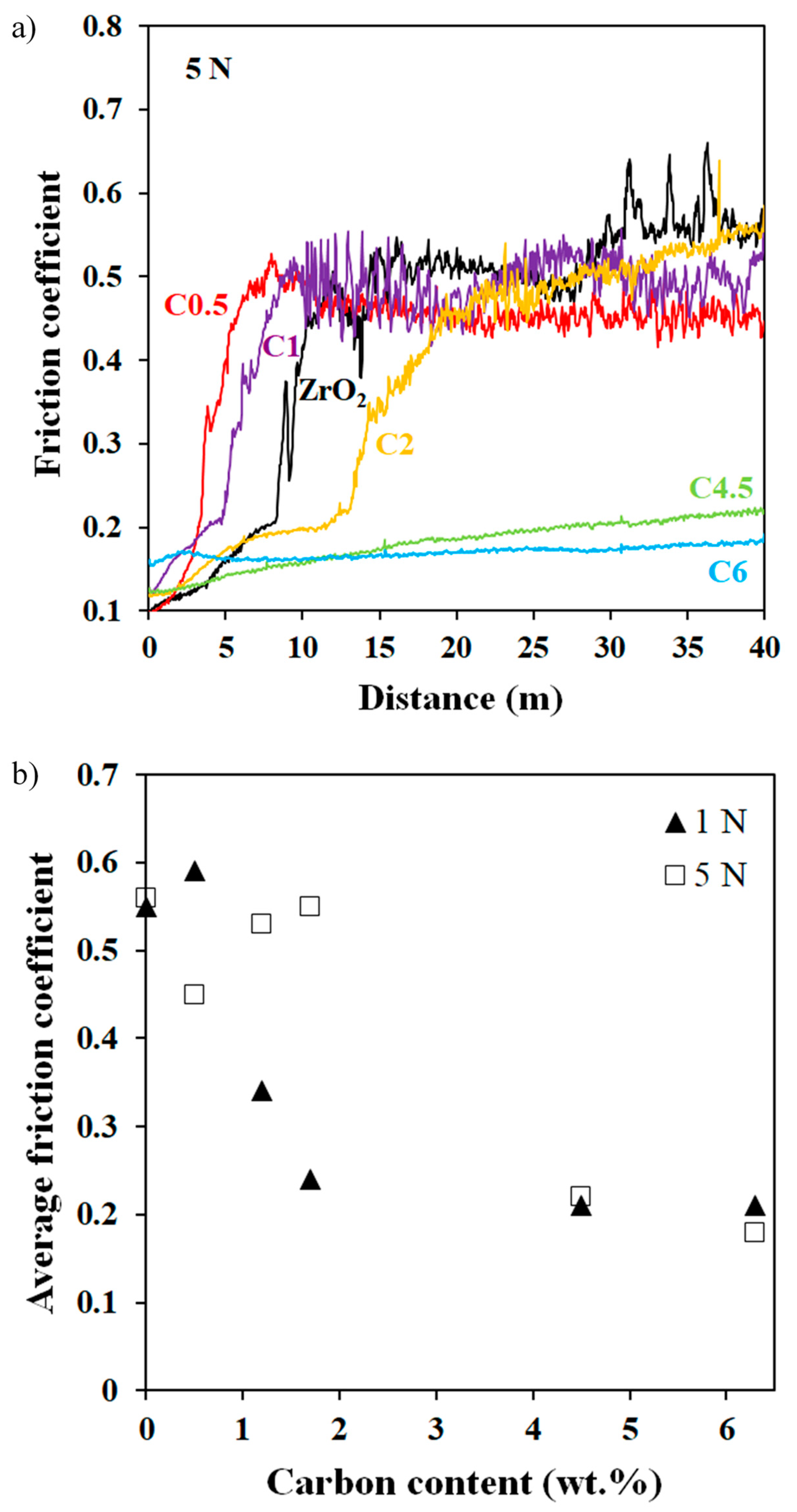

| Specimen | Cn (wt.%) | TSPS (°C) | d (%) | ID/IG (Min–Max) | HV (GPa) | Ra (µm) |
|---|---|---|---|---|---|---|
| 3YSZ | 0 | 1200 | 98 | - | 14.5 ± 0.3 | 0.01 |
| C0.5 | 0.5 | 1200 | 100 | 0.23 (0.09–0.72) | 13.8 ± 0.6 | - |
| C1 | 1.2 | 1200 | 100 | 0.74 (0.45–1.46) | 12.3 ± 0.8 | - |
| C2 | 1.7 | 1200 | 99 | 0.49 (0.37–0.61) | 11.7 ± 0.1 | 0.05 |
| C4.5 | 4.5 | 1200 | 98 | 1.07 (0.69–1.31) | 10.0 ± 2.8 | 0.07 |
| C6 | 6.3 | 1350 | 96 | 0.85 (0.33–1.20) | 9.5 ± 0.7 | 0.06 |
| Ball | F (N) | a (µm) | Pmax (MPa) | τmax (MPa) |
|---|---|---|---|---|
| alumina | 5 | 42 | 1346 | 586 |
| 10 | 53 | 1696 | 657 | |
| steel | 1 | 27 | 656 | 258 |
| 5 | 46 | 1122 | 421 |
Disclaimer/Publisher’s Note: The statements, opinions and data contained in all publications are solely those of the individual author(s) and contributor(s) and not of MDPI and/or the editor(s). MDPI and/or the editor(s) disclaim responsibility for any injury to people or property resulting from any ideas, methods, instructions or products referred to in the content. |
© 2024 by the authors. Licensee MDPI, Basel, Switzerland. This article is an open access article distributed under the terms and conditions of the Creative Commons Attribution (CC BY) license (https://creativecommons.org/licenses/by/4.0/).
Share and Cite
Kasperski, A.; Alkattan, D.; Turq, V.; Estournès, C.; Laurent, C.; Weibel, A. Friction and Wear Behavior of Double-Walled Carbon Nanotube-Yttria-Stabilized ZrO2 Nanocomposites Prepared by Spark Plasma Sintering. Materials 2024, 17, 3824. https://doi.org/10.3390/ma17153824
Kasperski A, Alkattan D, Turq V, Estournès C, Laurent C, Weibel A. Friction and Wear Behavior of Double-Walled Carbon Nanotube-Yttria-Stabilized ZrO2 Nanocomposites Prepared by Spark Plasma Sintering. Materials. 2024; 17(15):3824. https://doi.org/10.3390/ma17153824
Chicago/Turabian StyleKasperski, Anne, Dalya Alkattan, Viviane Turq, Claude Estournès, Christophe Laurent, and Alicia Weibel. 2024. "Friction and Wear Behavior of Double-Walled Carbon Nanotube-Yttria-Stabilized ZrO2 Nanocomposites Prepared by Spark Plasma Sintering" Materials 17, no. 15: 3824. https://doi.org/10.3390/ma17153824





